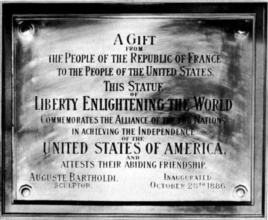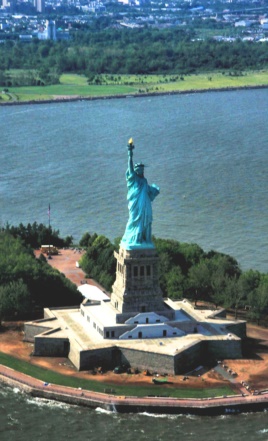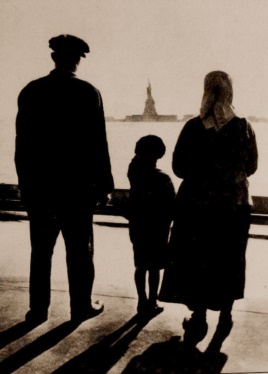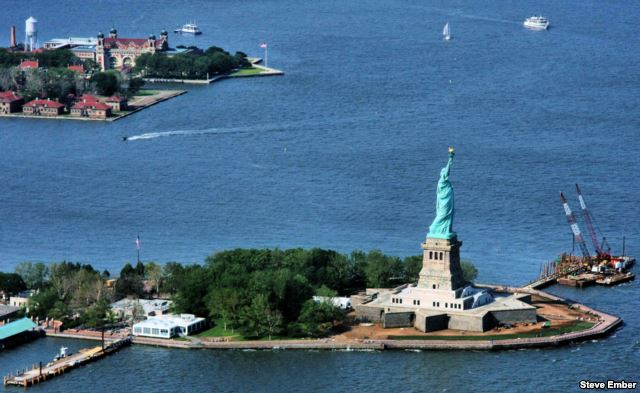VOA慢速英语:100年之后,自由女神像仍然吸引数百万的游客前来观光
From VOA Learning English, welcome to This is America. I'm Steve Ember.
Today we tell about the Statue of Liberty. The huge, green statue celebrates American freedom. It has served as the guardian of New York Harbor for more than a century.
Come along with us, as we visit “Lady Liberty.”
 |
| The dedication plaque on the Statue of Liberty |
The Statue of Liberty may be one of the most often photographed works of art in the world. A French sculptor, Frederic Auguste Bartholdi, designed the statue in the late 1800s. Today the monument continues to present a beautiful sight on the New York skyline. But it came close to never arriving in the United States.
The materials required for building the Statue of Liberty were almost lost at sea. In 1885, the ship carrying those materials almost sank in stormy seas. Bartholdi’s dream of a huge sculpture might never have been fulfilled.
Luckily, the ship survived the rough seas. It arrived safely in June of 1885. By the next year, the Statue of Liberty had arisen on what was then called Bedloe’s Island. The statue was officially opened that year. Many years later, the island was given a new name: Liberty Island.
She's a Survivor
The Statue of Liberty has survived damage caused by time, visits by millions of people and the weather. It stood firm during a destructive storm, Hurricane Sandy, which struck the East Coast in October of 2012. But Liberty Island suffered damage, requiring major repairs.
“Lady Liberty”, as many people call the statue, was a gift from the people of France. Its full name is “Liberty Enlightening the World.”
 |
| The Statue of Liberty from the air |
The United States and France have been friends and allies since the American Revolution. France helped the American colonial armies defeat British forces. The war officially ended in 1783. A few years later, the French rebelled against their king.
A French historian and political leader, Edouard-Rene Lefebvre de Laboulaye, had the idea for the statue. In 1865, he suggested that the French and the Americans build a monument together to celebrate freedom. Bartholdi agreed to design it.
In 1875, the French established an organization to raise money for Bartholdi’s creation. Two years later, an American group was formed to raise money to pay for a pedestal. American architect Richard Morris Hunt was chosen to design this support structure. The pedestal would stand 47 meters high.
In France, Bartholdi designed a model of the Statue of Liberty. Then he built a series of larger copies of the very small model statue. Workers created a wooden form covered with plaster for each part. They placed 300 pieces of copper on the forms. The copper skin was about two and one half millimeters thick, the same as two American pennies placed back-to-back.
The statue also needed a structure that could hold its weight -- more than 200tons. French engineer Alexandre Gustave Eiffel created the new technology. Later, he designed the famous Eiffel Tower in Paris.
Eiffel and others worked in Paris to produce a strong support system for the statue. The design also had to have the ability to move a little in strong winds. Lady Liberty has continued to stand during many a storm, including Hurricane Sandy.
France had wanted to give the statue to the United States on the 100th anniversary of the Declaration of Independence -- July fourth, 1876. But technical problems and lack of money delayed the project. France finally officially presented the statue to the United States in Paris in 1884. But the pedestal beingbuilt in New York was not finished. Not enough moneyhad been donated to complete the project.
 |
| An immigrant family views the Statue of Liberty from Ellis Island |
The publisher of the “New York World” newspapercame to the rescue. Joseph Pulitzer used hisnewspaper to persuade Americans to give more moneyto finish the pedestal. His efforts brought in another$100,000. And the pedestal was finished.
In France, workers separated the statue into 350pieces, put them on a ship and sent them across theocean. After surviving the rough seas, the statuearrived in New York in more than 200 wooden boxes. Ittook workers four months to build the statue on thepedestal.
On October 28th, 1886, President Grover Clevelandaccepted the statue in a ceremony. He said: “We will not forget that Libertyhas here made her home; nor shall her chosen altar be neglected.”
Throughout history, the idea of liberty has often been represented by imagesof a woman. Historians say the statue’s face was created to look likeBartholdi’s mother. Her right arm holds a torch high in the air. Her left armholds a tablet with the date of America’s Declaration of Independence -- Julyfourth, 1776.
On her head, the Statue of Liberty wears a crown with seven points. Eachpoint is meant to represent the light of freedom as it shines on the seven seasand seven continents of the world. The 25 windows in the crown representgemstones found on Earth. A chain that represents oppression lies broken ather feet.
Lady Liberty's message of hope
In 1903, a bronze plaque was placed on the inner wall of the statue’s pedestal. On it are words from the poem “The New Colossus,” written by EmmaLazarus in 1883. The marker represents the statue’s message of hope forpeople seeking freedom. One memorable line reads “I lift my lamp beside thegolden door.”
Not like the brazen giant of Greek fame,
With conquering limbs astride from land to land;
Here at our sea-washed, sunset gates shall stand
A mighty woman with a torch, whose flame
Is the imprisoned lightning, and her name
Mother of Exiles. From her beacon-hand
Glows world-wide welcome; her mild eyes command
The air-bridged harbor that twin cities frame.
"Keep ancient lands, your storied pomp!" cries she
With silent lips. "Give me your tired, your poor,
Your huddled masses yearning to breathe free,
The wretched refuse of your teeming shore.
Send these, the homeless, tempest-tost to me,
I lift my lamp beside the golden door!"
 |
|
This helicopter view shows how close the Statue of Liberty is to Ellis Island. Arriving immigrants would sail past "LadyLiberty" on their way to Ellis Island. |
Lady Liberty was officially named a National Monumentin 1924. The Statue of Liberty monument now includesnearby Ellis Island, the former federal immigrationprocessing center. Millions of immigrants, after theirships passed the Statue of Liberty, were examined onEllis Island between 1892 and 1924.
[Tour boat announcement]
"This view is similar to the one seen by immigrants as they entered the US bysteamship. When the ships neared New York, the shining torch of the Statueof Liberty rose from the bay. Shouts and cries of joy would erupt from thesteamer decks. For many, Liberty Enlightening the World, as the Statue isofficially titled, symbolized the freedom and opportunity that awaited them intheir new land."
More than 40 percent of Americans have at least one ancestor who passedthrough the processing center. Through the years, many of these peoplehave continued to visit the Statue of Liberty. Some people say a trip to NewYork City does not seem complete without it.
By the 1980’s, however, the statue was old and becoming dangerous forvisitors. In 1982, President Ronald Reagan asked businessman Lee Iacoccato lead a campaign to repair it.
The Statue of Liberty-Ellis Island Foundation raised about 100 million dollars inprivate donations to do the work. The repairs included replacing the torch andcovering it with 24 carat gold. On July fourth, 1986, New York City and thenation celebrated a restored and re-opened Statue of Liberty.
New York was one of the targets of the terrorist attacks of September 11th, 2001. The statue remained closed for security reasons until August 2004. At that time, officials limited visits to the pedestal and lower observation area. But that fact did not seem to keep too many people away. The statuecontinued to attract visitors -- more than three million a year.
Finally, in 2009, the statue above the pedestal re-opened. Limited groups ofenergetic people climbed the many steps leading to Lady Liberty’s crown.
On October 29th, 2011, the Statue again closed the inside of the pedestal forrestoration purposes. It opened on October 28th a year later -- for exactly oneday. The next day, Hurricane Sandy struck.
About 75 percent of the island was under water during the storm. Floodwaters entered the administration building and a structure filled with electricalequipment. The waters came close to the bottom of the statue, yet did nottouch it. Trees fell and waste cans flew from one side of the island to theother. Bricks broke away from walkways. But hundreds of Park Serviceemployees worked hard to help re-build the island.
Today, people can again explore Lady Liberty. But as usual, she is extremelypopular. Sometimes crowds wait for hours to get on a boat to visit America’sbig copper statue honoring freedom.
This program was written by Jerilyn Watson. I’m Steve Ember, inviting you tojoin us again next week for another This is America program from VOALearning English.
- 频道推荐
- |
- 全站推荐
- 推荐下载
- 网站推荐




















